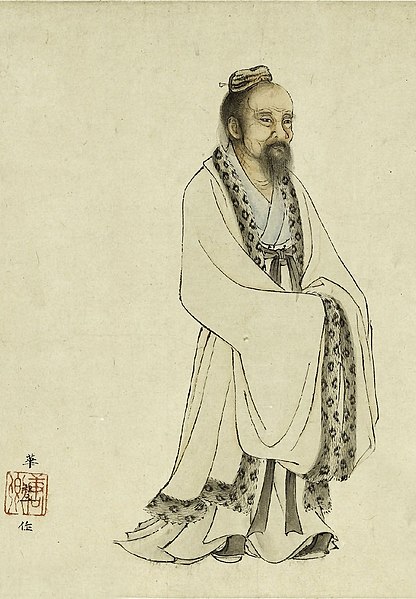In religious Daoism and traditional Chinese medicine, yangsheng, refers to various self-cultivation practices aimed at enhancing health and longevity. Yangsheng techniques include calisthenics, self-massage, breath exercises, meditation, internal and external Daoist alchemy, sexual activities, and dietetics.
Reconstructed drawings from the 168 BCE Daoyin tu (Chart for Guiding and Pulling [Qi Circulation]) in the Mawangdui Silk Texts
Manuscript written on bamboo strips, from the Kongzi Shilun (孔子詩論), an early discussion of the Classic of Poetry, Warring States period (c. 475-221 BCE)
Original silk fragments of the 168 BCE Daoyin tu (Chart for Guiding and Pulling [Qi Circulation]) in the Mawangdui Silk Texts
Zhuang Zhou, Yuan dynasty painting, 14th century
Daoyin is a series of cognitive body and mind unity exercises practiced as a form of Daoist neigong, meditation and mindfulness to cultivate jing (essence) and direct and refine qi, the internal energy of the body according to traditional Chinese medicine. These exercises are often divided into yin positions and yang positions. The practice of daoyin was a precursor of qigong, and was practised in Chinese Taoist monasteries for health and spiritual cultivation. Daoyin is also said to be a primary formative ingredient in the well-known "soft styles" of the Chinese martial arts, of tai chi, and middle road styles like Wuxingheqidao.
The Daoyin Tu, a painting on silk depicting the practice of daoyin; unearthed in 1973 in Hunan Province, China, from the 168 BC Western Han burial site of Mawangdui, Tomb Number 3.
Original Daoyin Tu Drawings of Guiding and Pulling in the Mawangdui Silk Texts
Reconstructed Daoyin tu Drawings of Guiding and Pulling in the Mawangdui Silk Texts

![Reconstructed drawings from the 168 BCE Daoyin tu (Chart for Guiding and Pulling [Qi Circulation]) in the Mawangdui Silk Texts](https://upload.wikimedia.org/wikipedia/commons/thumb/a/a5/Daoyin_tu_-_chart_for_leading_and_guiding_people_in_exercise_Wellcome_L0036007.jpg/640px-Daoyin_tu_-_chart_for_leading_and_guiding_people_in_exercise_Wellcome_L0036007.jpg)

![Original silk fragments of the 168 BCE Daoyin tu (Chart for Guiding and Pulling [Qi Circulation]) in the Mawangdui Silk Texts](https://upload.wikimedia.org/wikipedia/commons/thumb/a/ac/Qigong_taiji_meditation.jpg/640px-Qigong_taiji_meditation.jpg)

